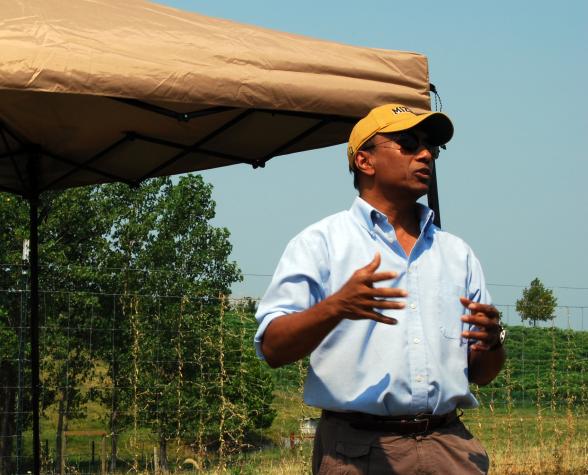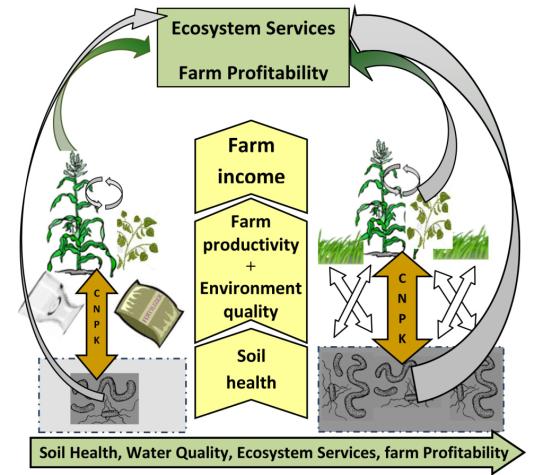Integrated cover crops study wins Conservation Innovation Grant
COLUMBIA, Mo. — They have intriguing names such as hairy vetch, pearl millet and birdsfoot trefoil. Collectively known as cover crops or green manure, they've been used for years to increase soil productivity by fixing atmospheric nitrogen into soil, making it available for cash crops such as corn and saving farmers money on input costs.
But fixing nitrogen is just one benefit of cover crops. They improve soil health because they add diversity to the microbial community, foster natural biological processes, boost organic matter and increase soil porosity, which improves soil’s water-holding capacity. What they capture is just as critical as what they add. Cover crops reduce soil erosion, sequester carbon and significantly mitigate nitrogen, phosphorus, and herbicide and pesticide losses to surface water.
Despite their myriad benefits, how to integrate them successfully into a production system still raises lots of questions for Missouri producers. Ranjith Udawatta, associate research professor in the College of Agriculture, Food and Natural Resources (CAFNR) at MU, and his collaborators aim to answer those questions and demonstrate cover crops’ benefits to soil health, water quality, ecosystem services and farm profitability.
Udawatta’s team was recently awarded a $500,000 Conservation Innovation Grant from the USDA Natural Resources Conservation Service to examine cover crop management practices in 12 watersheds in central and north-central Missouri. Several partners are contributing to the project, bringing the total budget to $1.1 million. Associated Electric Cooperative Inc. provided the principal research site in Chariton County.
According to EPA water quality studies, 44 percent of rivers, 30 percent of estuaries and 64 percent of lakes in the Mississippi River Basin are impacted by agricultural pollution and contribute to hypoxia in the Gulf of Mexico. Udawatta’s previous watershed research at the MU Greenley Memorial Research Center in Novelty, Mo., has shown that the bulk of the loss of nitrogen and phosphorus occurs during the fallow period, when the ground is bare.
Udawatta’s project will demonstrate the environmental benefits of adopting a production system focused on soil health and conservation practices. Researchers will measure reductions in soil erosion, and nitrogen, phosphorous, and herbicide and pesticide losses to surface water. They will measure improvements in soil and water quality and biomass production, and aim to enhance wildlife diversity as a result of planting field edge buffers and cover crops, which provide potential habitat.
What’s the bottom line? They’ll calculate that as well, measuring changes in productivity and decreased input costs from adopting an integrated cover cropping system. Finally, the project will develop and implement a user-friendly tool to recommend best management for cover crop selection, nitrogen application and economic return.
Not much cover crop data exists for Missouri, and this study, along with several cover crop projects at CAFNR’s out-state research centers, will bridge those knowledge gaps, providing technical information for farmers about which cover crops perform best for their area and cropping system and what machinery is needed to get the job done. Through the data they collect, the researchers will be able to add Missouri to the Midwest Cover Crop Council’s database, a decision tool that helps farmers choose the right cover crops for their production needs. They'll share their results at field days across the state.
In addition to the University of Missouri, this project involves several collaborators, including Associated Electric Cooperative Inc., Syngenta, Pioneer, Cover Crop Solutions, Chariton County Soil and Water Conservation District, Missouri Department of Natural Resources, Missouri Department of Conservation, USDA Agricultural Research Service, USDA Natural Resources Conservation Service and several participating farmers.
CAFNR is changing the core components of society that impact what we eat, where we live and how we’ll face tomorrow. As the University of Missouri’s College of Agriculture, Food and Natural Resources, we are at the forefront of research and education, working toward global sustainability.

